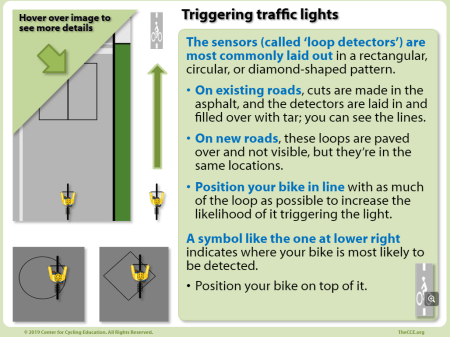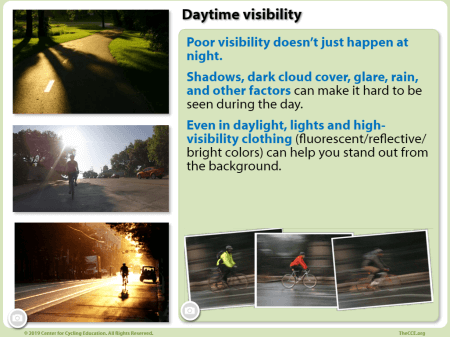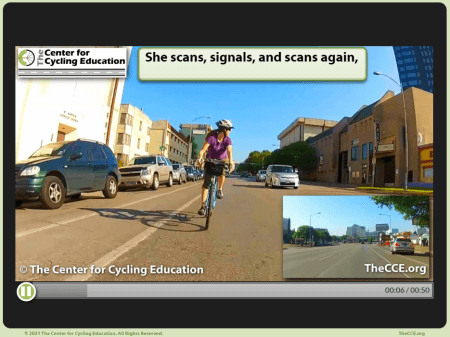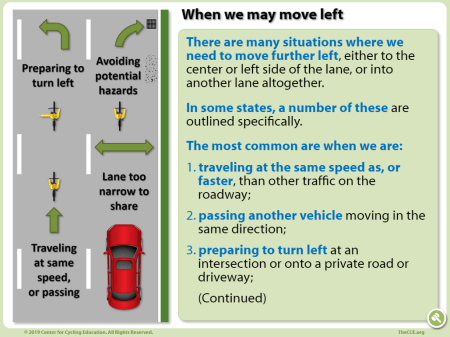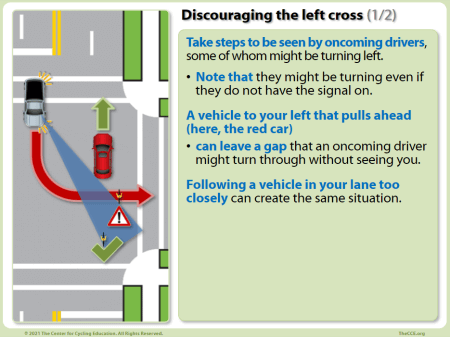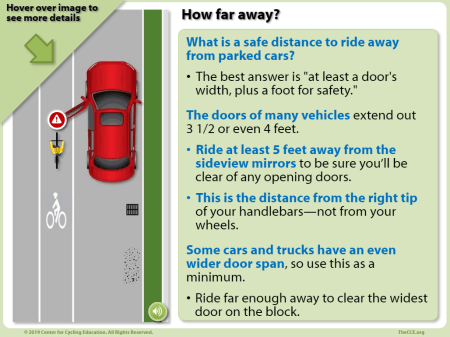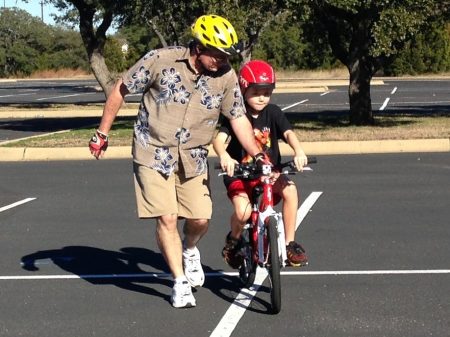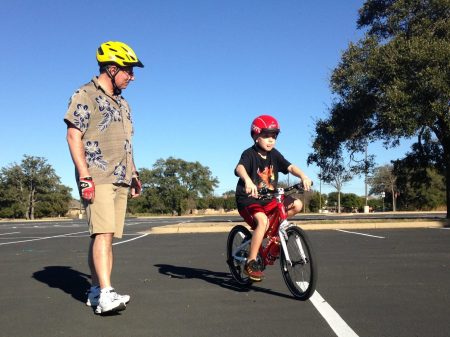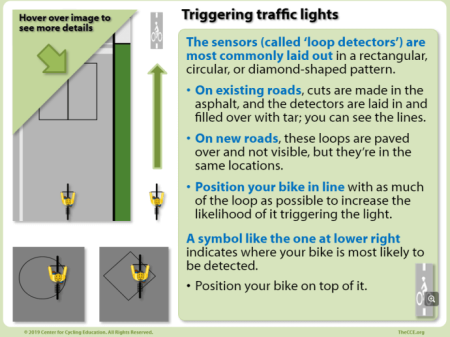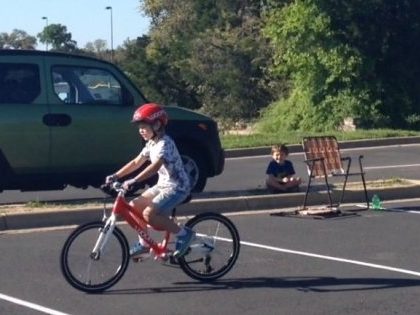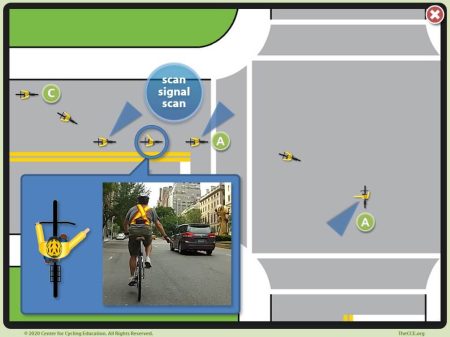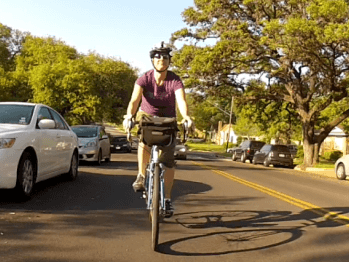Online ticket dismissal course for cyclists
Available for implementation anywhere in the USA and Canada.
For complimentary course access, and to begin the no-cost process for making this available in your jurisdiction, simply complete the form at the bottom of the page.
Since July of 2010, we have been offering an option to cyclists that had been available to drivers for years—having a traffic ticket waived in exchange for taking part in valuable, effective training.
Why offer the Defensive Cycling course to traffic citation defendants?
- No cost to the court or other agencies to implement the program.
- Course participants pay the $35 course fee, along with court fees and any associated costs.
- We handle all administration and interactions with participants.
- Proven content and platform.
- Multiple features to ensure full compliance as required by state education agencies.
- Security features for Certificates of Completion and their delivery.
- Years of experience in multiple jurisdictions.
Simple implementation requires only the following steps:
- Decide to offer the option to defendants.
- Provide a contact at the court who approves & oversees the program. (Name / position / email address / phone number)
- Provide a contact at the court who will receive Certificates of Completion via email. (Name / email address / phone number)
- Communicate the decision and details to court staff. (We provide a printable handout in PDF format.)
- Post the option on your court website, and police website if desired. (We provide the content, which you may edit as you see fit.)
One-off instances can be readily accommodated.
Do you have one individual wanting to take the training to dismiss a ticket? Simply provide them with the link to the course and us with your contact information, and we will take care of the rest.
 Providing this training offers all the benefits of a traditional ‘defensive driving’ course:
Providing this training offers all the benefits of a traditional ‘defensive driving’ course:
- Reduce demands on the courts and police services.
- Improve relations with defendants by providing an education alternative to a fine.
- Decrease the likelihood of repeat offenses.
- Increase road safety.
 Created by cycling instructors, for cyclists.
Created by cycling instructors, for cyclists.
Many jurisdictions offer defendants the option to take a defensive driving course to dismiss a ticket. While there is considerable overlap in the laws governing driving a motor vehicle and riding a bicycle, teaching why and how a cyclist should follow these laws requires specific skills and a different psychological approach.
 All course administration is handled by The Center for Cycling Education, including:
All course administration is handled by The Center for Cycling Education, including:
- Registrations.
- Payments.
- Inquiries from participants.
- Tracking and verification of course progress & completion.
- Creation of the Certificate of Completion for each participant.
- Confirmed delivery of the certificate to the court via email, with the participant being copied on the message.*
* Should you require that participants deliver their certificate in person or by mail, we can make these arrangements.
 By taking this course, participants will:
By taking this course, participants will:
- Reduce the likelihood of receiving further citations.
- Learn the traffic laws that apply to them.
- Explore the many reasons why they benefit from following them.
- Understand the impact of their actions in traffic.
- Become more cooperative and competent on the road.
- Gain significant skills for riding in traffic.
 Exceeds national cycling education standards.
Exceeds national cycling education standards.
The course significantly exceeds the traffic skills training requirements for the national programs in United States and Canada:
- League of American Bicyclists’ ‘Smart Cycling’ program
- Cycling Canada’s ‘CAN-BIKE’ program
Its content and methodology were modeled after state and provincial government standards for defensive driving courses.
With more than 19 years’ experience as an instructor, the primary course developer has been both a Master Instructor with the League of American Bicyclists and a National Examiner with the Canadian Cycling Association (now Cycling Canada). Others with these credentials, and numerous instructors with each program, helped develop and review the content and delivery.
 Highly effective
Highly effective
In a survey directly following the course, participants have been asked the following questions. Here are the responses to date:
| “Has this training influenced you to ride according to the law?” | 88% said 'Yes.' |
| “Did this training help you feel more confident about cycling in traffic?” | 93% said 'Yes.' |
 Tested and proven content & platform.
Tested and proven content & platform.
The course was developed in 2010 by The Center for Cycling Education as a classroom offering. This was carried out in conjunction with the Austin Cycling Association (now Bike Austin), the City of Austin Municipal Court, and Bike Texas (the statewide cycling advocacy organization). 70 classroom sessions were conducted before the online course was launched in April 2013.
More than 1500 people have taken the classroom or online course to dismiss a traffic ticket. Many others have taken the online course out of general interest, to gain a pedicab license, or to meet training requirements for their employers. The content is designed to be applicable for cyclists of all experience levels.
The systems used to develop and deliver this training are industry-leading, and we have years of experience in their use and implementation.
For complimentary course access, and to begin the no-cost process for making this available in your jurisdiction,
simply complete the form at the bottom of the page.
 Easy for defendants to take part in this ‘ticket dismissal’ option:
Easy for defendants to take part in this ‘ticket dismissal’ option:
Cost: $35
Duration: Approximately 5 hours
- Complete and submit a Deferred Disposition form through the court, along with the payment of the court fee and any other associated charges.
- Sign up for the online course.
- Complete the course with a passing grade (80%).
- A Certificate of Completion will be prepared and emailed directly to the court, or sent to the participant to deliver to the court (depending on your court’s requirements).
- Once the certificate is processed, the fine will be waived and the ticket dismissed.
Here is what is explored in the course:
Being an MVP-C
Being an MVP-C
- What does this mean?
- Manoeuvrable: Creating space around you
- Visible: Being seen, day and night
- Overview
- Daytime visibility
- Nighttime visibility
- Lights & lighting configurations
- Clothing
- Predictable: Helping others make the right decisions
- Set up mutual communication
- Make your own decisions
- Know what’s coming
- Give advance notice
- Other ways to make it easier
- Communicative: Getting across the right messages
- Overview
- What do we need to communicate?
- How can we communicate?
- Lane choice & lane positioning
- Hand signals, higher cadence, eye contact, sound
- Think people, not cars
- Making it positive
- Putting it all together: MVP-C
Equipment
Equipment
Optional: Parts of the bike
Checking your bike for safety
- ABC Quick Check
- A more detailed check
- ‘Do it yourself’ vs. ‘Let them do it’
Sizing, configuring, & adjusting your bike
- Checking for fit
- 1) Frame size
- 2) Saddle height
- 3) Saddle position: forward/back/tilt
- 4) Handlebar position
- Making adjustments
Required & optional equipment
- Brakes
- Lighting
- What’s needed, and when
- Lights & lighting configurations
- Reflectors & reflective materials
- Using more than the basics
- Helmets
- Overview
- Choosing a helmet
- Wearing it right
- Putting the helmet on
- Checking that it’s the proper size
- Including fixed-gear bikes (‘fixies’)
Parking your bike
- Deterring bike theft
- Where to park your bike
- How to lock it up
- What kind of locks?
- Just in case… (insurance & registration with police)
Bike handling skills
Bike handling skills
Braking
- Practicing out of traffic
- Using the right touch
- Covering the brakes
- A two-step method
- The front brake, & how much
- If the rear wheel skids
- Both hands on the bar
- Planning ahead
- Brake on clean surfaces
- Slippery when wet
- Dry the brakes in wet conditions
Pedalling at a higher cadence (RPM)
- Physical benefits
- Communication benefits
- How fast should you pedal?
Riding in a straight line
- Three key elements
Scanning behind
- Getting a 360° view
- Steps to make it easier
- Practicing the technique
- Refining the technique
Optional section: Shifting gears
- What do we mean by ‘gears’?
- The purpose of shifting
- Derailleurs
- How many gears does my bike have?
- Choosing a gear
- What gear am I in?
- When to shift: speeding up/going downhill
- When to shift: slowing down/climbing hills
- Shifting: front vs. back
- Shifting: front & back at same time
- Reducing wear on gears & chain
- If the chain comes off
How people behave in traffic
How people behave in traffic
- Your reaction to other people’s errors
- Video: It’s a 3-Way Street
- How do these behaviours come about?
- Your attitude and its impact
- Monitoring your thoughts
- Evaluating your skills
- Learning from your experiences
Your rights & duties
Your rights & duties
Knowing your true place in traffic
- The same rights & duties
- “But you don’t pay for the roads!” (Yes, we do.)
What’s the point of the law?
- Knowing what to expect
- Making decisions easier
- Demonstrating what we expect
- Our effect on other cyclists
- Deterrence & compensation
- Order & safety vs. convenience
- What a traffic ticket means to you
- The cost of a ticket
An overview of traffic laws
- Multiple levels of traffic laws
- Case law
- Where do these laws apply?
- How are the laws written?
- Drivers’ duties toward us
- Disclaimer
A summary of common cycling laws
- A quick snapshot
- Rights & duties of cyclists
- Operation of the bicycle
- Position on the road
- Sidewalk riding
- Signalling
- Riding side-by-side
- Equipment requirements
- Drugs & alcohol
- Other
- Bicycle as a vehicle
- Electric bikes
- Registration & licensing
- Parking
- Collision
Scanning & signalling
Scanning & signalling
Scanning for traffic
- Why it’s important
- Review of steps to make it easier
- When to scan
- Using mirrors
Signalling
- Why it’s important
- What we need to signal, and tips to make it easier
- Turns
- Lane changes
- Change of position within a lane
- Stops
- Pulling onto the roadway
- Waving thanks
- Signalling—how, and how often?
Putting it all together
- Scan, Signal, Scan, (if it’s safe) Go.
- How this looks in real life
Choosing your place on the road
Choosing your place on the road
Choosing a lane & lane position
- A reasoned approach
- Seeing things from a driver’s perspective
- Ride with traffic
- Risks of wrong-way riding
- How to choose your lane position
- Avoiding roadside hazards
- Giving ourselves space
- How far right?
- When you can move left
- Controlling the lane
- How this helps drivers
- What your options are
- Communicating with others
- Some important considerations
- Riding on one-way streets
- What does controlling the lane look like?
Parked cars
- The potential risks
- What’s a safe distance?
- Legal responsibility for drivers & passengers
- What a safe distance looks like
Bike lanes
- Do we have to ride in them?
- What are your options?
Intersections
Intersections
Lane position at intersections
- A, B or C position?
- Common driver errors at intersections, and how to discourage them
- Stopping at an intersection
- Positioning in bike lanes and at 4-way stops
- Travelling through the intersection
- If you ride in ‘C’ position
- If a driver turns across your path
- Regardless of what lane position you take…
- Right turn only lanes
When stopping is required
- Stop signs & red lights
- What might you miss?
- Go! No, stop!
- Fewer decisions are needed
- Drivers’ perceptions
- The cost of a ticket
- What is the point of the law?
- Where to stop
Right of way
- Don’t assume you have it
- First come, first served
- Yield to the person on the right
- Yield if you are turning
- Taking your turn
- Pedestrians’ right of way
- Which is a legal crosswalk?
- Communicate with others
Traffic lights
- Why a green light doesn’t mean ‘go’
- Judging the timing
- Starting off quickly
- Triggering traffic lights
Making turns
- Right turns
- Left turns
- Changing lanes: moving from ‘C’ position
- Changing lanes: with traffic around you
- Changing lanes: signalling
- Changing lanes: with no traffic around you
- Using the gaps
- Preparing for the turn
- Lane position for the turn
- Waiting position
- Making the turn
Traffic circles & roundabouts
- Efficient, but confusing for some
- Order of priority
- Go clockwise around the center
- Signal directly before you exit
- Video: How it looks in real life
Other riding situations
Riding:
- on sidewalks
- near buses & trucks
- side-by-side
- on paths & trails
Summary & feedback
Summary & feedback
- Includes an option for a brief survey so you can let us know what you think of the course.
Complimentary sections from our courses:
(Links open in new window.)
Traffic skills
Bike handling skills
Equipment
Get complimentary access to the course, and request your jurisdiction’s no-cost participation in this program.
Simply complete the form below, and we will provide you with complimentary access so you may review the course. We will also send you a summary of the simple steps that will allow you to offer this education option to cyclists who are ticketed in your jurisdiction.
Please note that the course enrollment process is done manually. It may take up to a full business day to complete, but we make these requests a high priority. If you need access more immediately, feel free to call or text us at the phone number on our contact page.
To be sure you receive our response to your form submission, please:
• Provide your phone number (optional) so we can reach you if our reply is lost or accidentally deleted.
• Check your spam/junk mail folder.
The form should display directly below. If it is not visible, please
email us at contact@thecce.org, or call/text us at 1 (306) 370-2453.
